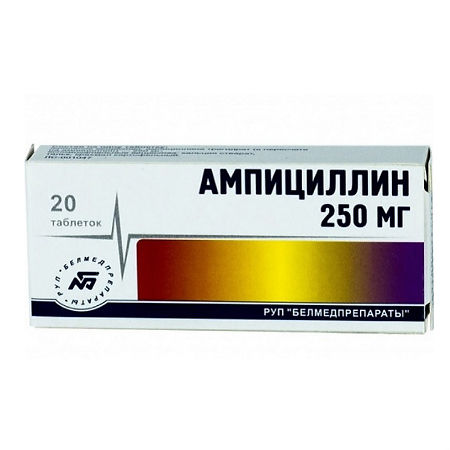No products in the cart.
Ampicillin, tablets 250 mg, 20 pcs.
€1.00
Out of stock
(E-mail when Stock is available)
Description
Ampicillin is a semisynthetic penicillin, broad-spectrum, bactericidal. It is acid-resistant. It suppresses the synthesis of the bacterial cell wall.
It is active against Gram-positive (alpha- and beta-hemolytic Streptococci, including Streptococcus pneumoniae, Staphylococcus spp, Bacillus anthracis, Clostridium spp, moderately active against most Enterococcus spp, including Enterococcus faecalis, Listeria spp.) and gram-negative (Haemophilus influenzae, Neisseria meningitidis, Neisseria gonorrhoeae, Proteus mirabilis, Yersinia multocida (previously Pasteurella), many species of Salmonella spp., Shigella spp., Escherichia coli) microorganisms, aerobic non-producing bacteria.
Ineffective against penicillinase-producing strains of Staphylococcus spp., all strains of Pseudomonas aeruginosa, most strains of Klebsiella spp. and Enterobacter spp.
Pharmacokinetics
After oral administration ampicillin has a low degree of absorption from the gastrointestinal tract.
Ingestion with food further reduces absorption of the drug. Ampicillin penetrates into bronchial secretions, sinuses, middle ear, cerebrospinal fluid; it is excreted with breast milk and penetrates into amniotic fluid.
Indications
Indications
Bacterial infections caused by sensitive pathogens:
Active ingredient
Active ingredient
Composition
Composition
1 tablet contains:
the active ingredient:
ampicillin trihydrate 250 mg.
How to take, the dosage
How to take, the dosage
Dosing regimen is set individually depending on the severity of the course and localization of the infection, the sensitivity of the pathogen to the drug.
Ampicillin trihydrate is taken orally regardless of meals. A single dose for adults is 0.25-0.5 g, daily dose is 1-3 g. A daily dose of 50-100 mg/kg body weight is prescribed for children. Children with body weight up to 20 kg are prescribed in doses of 12.5-25 mg/kg. The daily dose is divided into 3-4 doses.
The duration of therapy with Ampicillin trihydrate is determined individually depending on the severity of the disease and the effectiveness of treatment.
Interaction
Interaction
Bactericidal antibiotics (including aminoglycosides, cephalosporins, cycloserine, vancomycin, rifampicin) have a synergistic effect; bacteriostatic drugs (macrolides, chloramphenicol, lincosamides, tetracyclines, sulfonamides) – antagonistic.
Indirect anticoagulants increase the effectiveness (by suppressing intestinal microflora, reduces the synthesis of vitamin K and prothrombin index); reduces the effectiveness of estrogen-containing oral contraceptives (additional methods of contraception must be used), drugs, in the metabolism of which paraaminobenzoic acid is formed, ethinylestradiol (in the latter case the risk of bleeding “breakthrough” increases).
Diuretics, allopurinol, oxyphenbutazone, phenylbutazone, nonsteroidal anti-inflammatory drugs and other drugs that block tubular secretion increase the concentration of ampicillin in plasma (by reducing tubular secretion).
Allopurinol increases the risk of skin rash.
Reduces the clearance and increases the toxicity of methotrexate.
Special Instructions
Special Instructions
At the beginning of therapy, appropriate tests should be performed to identify the microorganisms causing the disease and to assess sensitivity to ampicillin. Ampicillin therapy may be started before the results of these tests are available. When the results of the tests are known, therapy should be continued according to the findings.
Hematopoietic, hepatic and renal function must be monitored during treatment.
The development of superinfection due to growth of microflora insensitive to it is possible, which requires appropriate change in antibiotic therapy.
When administered to patients with sepsis a bacteriolysis reaction may develop (Jarisch-Herxheimer reaction).
In mild infections in children it is preferable to prescribe the drug in the form of suspension.
In patients who are hypersensitive to penicillins, cross-allergic reactions with other beta-lactam antibiotics are possible.
In treatment of mild diarrhea that occurs with a course of treatment, anti-diarrheal drugs that reduce intestinal peristalsis should be avoided; kaolin- or attapulgit-containing anti-diarrheal drugs can be used; cancellation of the drug is indicated. If the diarrhea is severe, a physician should be consulted.
Treatment must be continued for an additional 48-72 hours after clinical signs of illness have disappeared.
Impact on the ability to drive vehicles and operate complex machinery.
With regard to the side effect of ampicillin on the nervous system (headache, tremors, seizures, confusion) during the period of treatment one should refrain from driving motor transport and carrying out other potentially dangerous activities requiring increased concentration and rapid psychomotor reactions.
Contraindications
Contraindications
Side effects
Side effects
Allergic reactions: skin itching and flaking, urticaria, rhinitis, conjunctivitis, angioneurotic edema, fever, arthralgia, eosinophilia, erythematous and maculopapular rash, exfoliative dermatitis, erythema multiforme exudative (including Stevens-Johnson syndrome).including Stevens-Johnson syndrome), serum-like reactions, anaphylactic shock, non-allergic ampicillin rash, may disappear without withdrawal of the drug.
Digestive system disorders: dysbacteriosis, stomatitis, gastritis, dry oral mucosa, change in taste, abdominal pain, vomiting, nausea, diarrhea, glossitis, moderate increase in “liver” transaminases activity, pseudomembranous colitis.
Central nervous system disorders: headache, tremors, convulsions (in high-dose therapy), agitation, aggressiveness, anxiety, confusion, altered behavior, depression.
Laboratory findings: leukopenia, neutropenia, thrombocytopenia, agranulocytosis, anemia.
Local reactions: pain at the injection site, infiltrates when administered intramuscularly, phlebitis when administered intravenously in high doses.
Others: interstitial nephritis, nephropathy, superinfection (especially in patients with chronic diseases or reduced body resistance), vaginal candidiasis.
Overdose
Overdose
Symptoms: manifestations of toxic effects on the central nervous system (especially in patients with renal failure); nausea, vomiting, diarrhea, water-electrolyte imbalance (as a consequence of vomiting and diarrhea).
Treatment: drugs to maintain water-electrolyte balance and symptomatic. Excreted with hemodialysis.
Pregnancy use
Pregnancy use
In pregnancy, use is possible if the expected effect of therapy on the mother exceeds the potential risk to the fetus.
The FDA fetal category is B (animal reproduction studies have not shown a risk of adverse effects on the fetus, and adequate and well-controlled studies in pregnant women have not been conducted).
Breastfeeding should be stopped during treatment.
Additional information
| Shelf life | 2 years |
|---|---|
| Conditions of storage | In a dry place, at a temperature not exceeding 25 °C |
| Manufacturer | Belmedpreparaty, Belarus |
| Medication form | pills |
| Brand | Belmedpreparaty |
Related products
Buy Ampicillin, tablets 250 mg, 20 pcs. with delivery to USA, UK, Europe and over 120 other countries.














